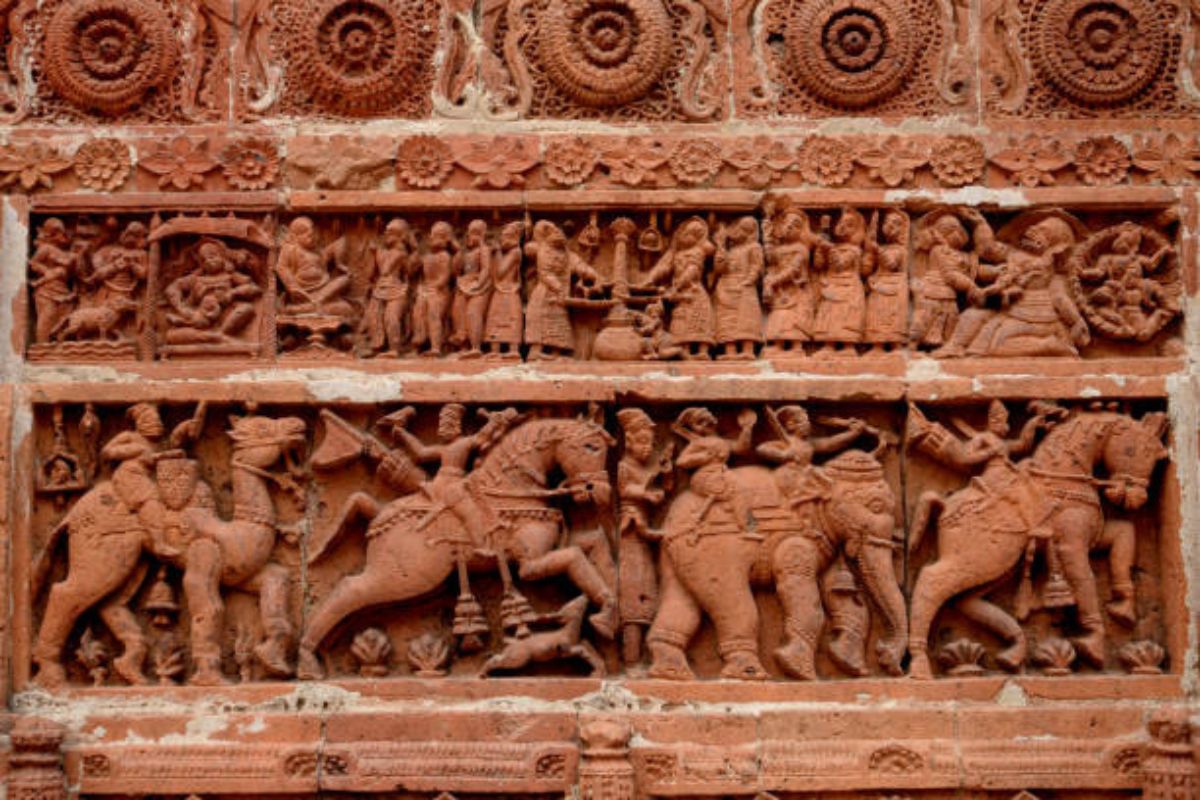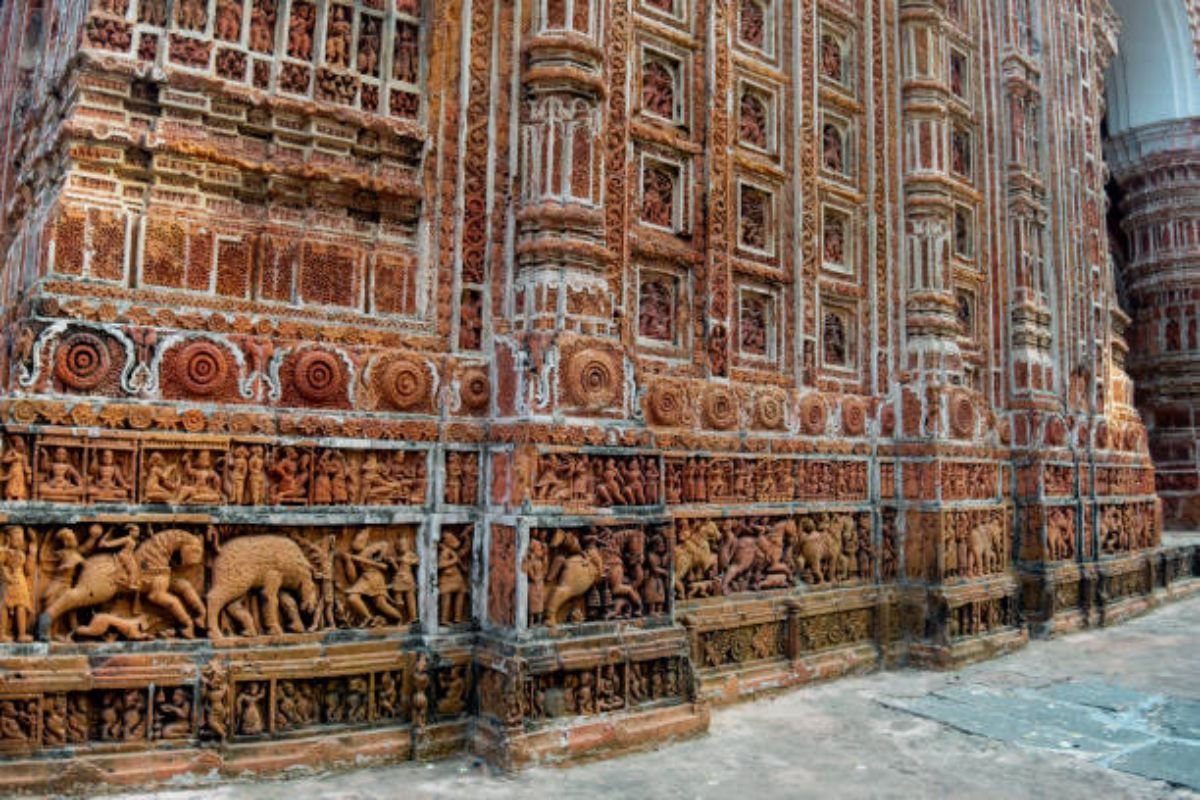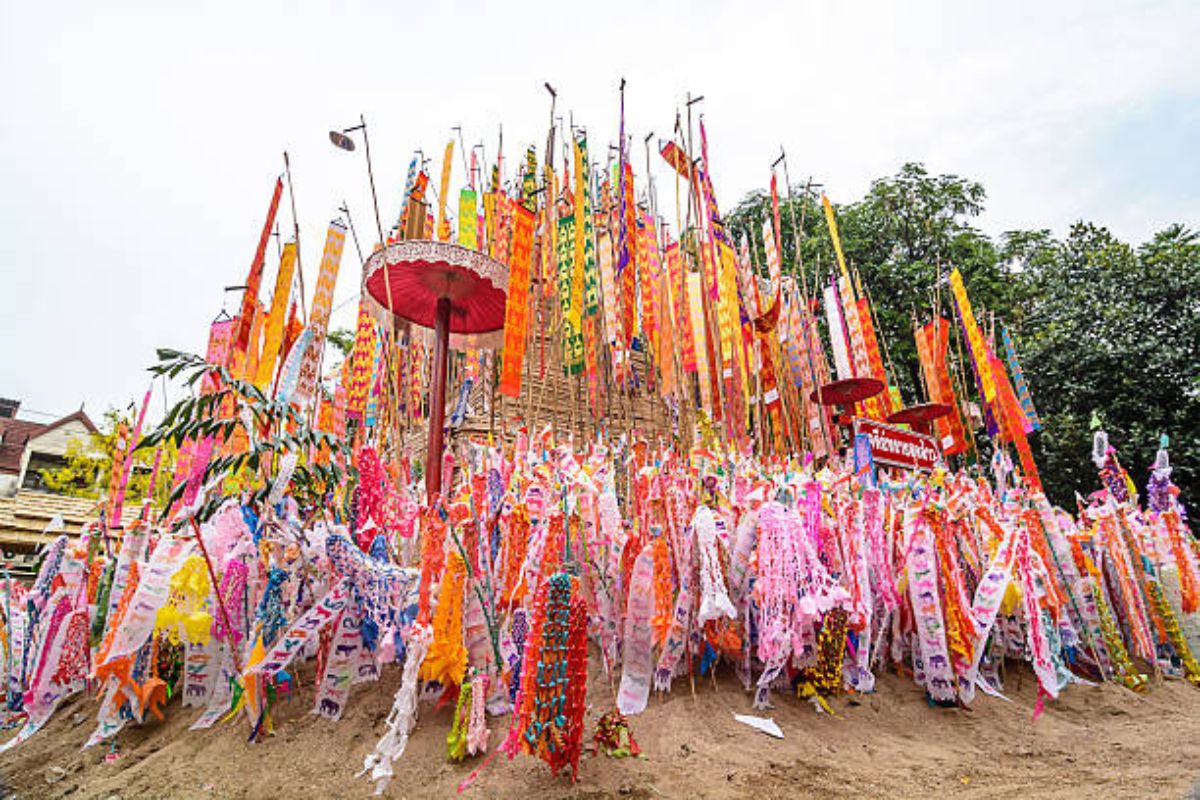Kantajew Temple - The Most Beautiful Terracotta Temple in Bangladesh
Kantajew Temple, located in the northern Bengali region of Dinajpur, is a must-see destination for everyone interested in history or architecture, as well as all travelers. Raja Ramnath built the temple in the 18th century, and it is an excellent example of a terracotta building.
Kantajew Temple attracts visitors from far and wide for its religious importance and architectural splendor. In this article, you will get all the details about Kantajew Temple from historical, religious, and travel perspectives. Let’s get into it.
Kantajew Temple- Beautiful Terracotta Temple in Bangladesh
A masterpiece of 18th-century architecture, Kantajew Temple is adorned with exquisite terracotta carvings, that narrate tales of mythology and history. This Hindu temple, dedicated to Krishna and Rukmini, stands as a testament to the rich cultural heritage of Bangladesh. Its intricate designs and unparalleled beauty have earned it the title of the most stunning terracotta temple in the country.
 For those seeking a deeper understanding of Bangladesh's historical and cultural heritage, Kantajew Temple is a must-visit site. You can explore more about this breathtaking temple from Rajshahi Tour Packages with ITS Holidays Ltd, a travel guide that offers insights into the best historical sites in Bangladesh.
For those seeking a deeper understanding of Bangladesh's historical and cultural heritage, Kantajew Temple is a must-visit site. You can explore more about this breathtaking temple from Rajshahi Tour Packages with ITS Holidays Ltd, a travel guide that offers insights into the best historical sites in Bangladesh.
History
According to records, King Pran Nath began building this temple in 1704. Despite his strong interest, King Pran Nath was unable to complete the construction of this temple. When King Pran Nath died in 1722, his adopted son, King Ram Nath, resumed his work. There is historical information, and people are reminded that hundreds of workers worked for 48 years to build the temple, which was completed in 1752. Source: Wikipedia
The temple has been well-maintained over the years and has been declared a UNESCO World Heritage Site. It is a popular destination for tourists and history enthusiasts alike. It is also a valuable cultural and architectural landmark that tells the story of Bengal's rich history.
Location
Kantajew Temple was built in the 18th century. The temple is located 20 kilometers north of Dinajpur, Bangladesh, and 7 kilometers south of Kahorol Upazila Sadar in the Sundarpur Union, on the west side of the Dinajpur-Tentulia highway, on the banks of the river Dendampa, a sacred structure in Kantanagar.
Kantajew Temple is well-known for its Bengali architectural features; one of the key reasons for its popularity is that mythological stories have been embellished on the walls with clay embellishments. The earthquake of 1897 obliterated the original nine peaks.
Construction
There is a Sanskrit inscription in the eastern corner that states that the Maharaja of Dinajpur, Pran Nath, began construction of the temple. After his death, his adopted son Ramnath finished building the temple.
Maharaja Prannath began the construction in 1722 AD. His adopted son Maharaja Ramnath completed it in 1752 to fulfill his father's dream of adapting the Radha-Krishna temple. Maharaja Girijanath Bahadur renovated it in the early twentieth century, but he was unable to adopt the nine pillars because they had been destroyed by an earthquake.
However, there is significant confusion over the construction of this temple. The chronogram in the Sanskrit stone inscription notes that the building began in 1722. So it is thought that the building began around 1722.
Characteristics
A common feature of the excellent terra cotta embellishment of the Kantajew temple is that it depicts the social history of the time; there are no adult scenes depicted on the terracotta. Terracotta work covers the temple's whole wall. The Terracotta tradition continues.
Ramayana, Mahabharata, and other myths have been described here. The temple's four walls are painted with the legends of the four Shastras: truth, Treta, Dapor, and Kali. The terracotta of Kantajew temple transports you to medieval Bengal and tells a mythological story. The temple boasts the most high-quality terracotta in Bangladesh.
Puranic Significance
This temple is dedicated to Krishna and his wife Rukmini. It is an example of Bangladeshi terracotta architecture, with nine spires that were all destroyed in an earthquake in 1897. Before the destruction caused by the 1897 earthquake, the temple was erected in the navaratna (nine-spire) style.
The characteristic features of the erections are the four centered and wide multi-cusped arches, the plastered surface of the walls having immense rectangular and square panelings, prominence of the central archway, and the central mihirab by making the slightly larger and setting in a projected fronton in the outside directions, the use of ornamental turrets on the either side of the fronton, the semi-octagonal mirirab apertures, the archway opening under half-domes, the Persian muquarnas work in stucco inside the half-domes over the entrance arches and mihirab niches, the bulbous outline of the domes with constricted necks, domes on octagonal drums with lotus and kalasa finials as the crowning elements, the round pendentives to make up the phase of transition for the domes and the multi-faced corner towers rising high above the horizontal merloned parapets.
Architectural Detail
This spectacular pyramid-shaped temple has risen beyond three steps, with nine ornamental peaks or gems above the three-legged corners, which resemble a massive ornate rope standing on a high base. The temple has an open archway around it, allowing worshipers to glimpse the image of God in the inner sanctuary from any angle. The square temple sits on a rectangular courtyard.
There is a space for worshipers to sit in the center of the area, which is corrugated. The plaza's main square forms the focal point of the entire edifice. The temple stands on a stone base and is more than 50 feet tall.
It is thought to have been erected using construction materials brought from the ruins of Bannagar near Gangarampur (Dinajpur). The outside side is linked to three quadrangular rooms built high. This design has strengthened the central committee, so the top chamber may be preserved for this cell.
Terracotta works
The most impressive feature of the Kantajew temple is the uninterrupted sequence of floral terracotta. The terracotta area depicts the Ramayana and Mahabharata stories, Krishna's stories, and a succession of fascinating contemporary societal scenarios.
 The terracotta section serves as both a decorative element and a collection of mythological and religious literature. Terracotta structure modeling, attractiveness, and positions are very stunning and magnificent to look at. Religious stories are well depicted in the terracotta, and the temple has the most beautiful terracotta design in the country.
The terracotta section serves as both a decorative element and a collection of mythological and religious literature. Terracotta structure modeling, attractiveness, and positions are very stunning and magnificent to look at. Religious stories are well depicted in the terracotta, and the temple has the most beautiful terracotta design in the country.
The temple's walls are completely different from the rest of the country's terracotta works. There are some similarities between the works from the Pala dynasty in the seventh century. A very magnificent scheme of decoration is found here with sophisticated mature art.
Festivals at Kantajew Temple
Every year the temple hosts Rashmela, on the occasion of Kathik Purnima/Rash Purnima (usually happens at the end of November). Fifteen days before the festival starts, temple Gods Radha and Krishna travel to Dinajpur Rajbari which is considered Radha’s home, through a boat journey on Punarbhava River. After 15 days, they return to Kantajew Mandir on a Palki or palanquin. Then they perform a chakra around the temple (circumambulation) and take their place and thus the 1 month long Rash Mela or Festival starts.
 The festival is observed by people from all walks of life. Thousands of devotees from India, Nepal, as well as across Bangladesh. Magura, Mymensigh, Patuakhali, Nilphamari, and Bhola pay their homage. Many spend the festival night around the temple area, believing that such rituals can promote the welfare of society. During this period, the temple authorities provide food and entertainment.
The festival is observed by people from all walks of life. Thousands of devotees from India, Nepal, as well as across Bangladesh. Magura, Mymensigh, Patuakhali, Nilphamari, and Bhola pay their homage. Many spend the festival night around the temple area, believing that such rituals can promote the welfare of society. During this period, the temple authorities provide food and entertainment.
The latter includes ritual songs and Radha-Krishna dances, much to the delight of the pilgrims and in keeping with traditional temple hospitality. Besides the clergy of the Temple, the Festival draws performers, musicians, local craftspeople, and local cuisine.
Kantajew Hindu Temple and Museum Visiting Hours
Kantajew temple is more or less always open during the day for visitors and pilgrims. No ticket is required to visit the temple alone. The museum follows the below visiting hours, and a ticket is required for a visit.
|
Days |
Summer: 1 Apr to 30 Sep |
Winter: 1 Oct to 31 Mar |
During Ramadan |
|
Friday |
10:00 AM to 12:30 PM, and 2:00 PM to 6:00 PM |
9:00 AM to 12 PM, and 2 PM to 5 PM |
2.00 PM–4.00 PM |
|
Saturday |
10:00 AM to 6:00 PM |
9:00 AM to 5:00 PM |
10:00 AM to 4:00 PM |
|
Sunday |
The museum remains closed on Sundays and any other public holidays. |
||
|
Monday |
2:00 PM to 6:00 PM |
1:30 PM to 5:00 PM |
10:00 AM to 4:00 PM |
|
Tuesday |
10:00 AM to 6:00 PM |
9:00 AM to 5:00 PM |
10:00 AM to 4:00 PM |
|
Wednesday |
10:00 AM to 6:00 PM |
9:00 AM to 5:00 PM |
10:00 AM to 4:00 PM |
|
Thursday |
10:00 AM to 6:00 PM |
9:00 AM to 5:00 PM |
10:00 AM to 4:00 PM |
Kantajew Temple and Museum Ticket Price
|
Nationality |
Ticket Price |
|
No ticket is required to visit the temple alone but for the site museum. |
|
|
Students (Bangladeshi) up to the secondary level |
5.00 taka |
|
Bangladeshi |
20.00 Taka |
|
Visitors from SAARC member countries |
100.00 Taka |
|
And any other foreign nationalities |
200.00 Taka |
The South Asian Association for Regional Cooperation (SAARC) has eight member countries
(Afghanistan, Bangladesh, Bhutan, India, the Maldives, Nepal, Pakistan, and Sri Lanka).
How to Go to Kantajew Temple
There is a chance to travel from Dhaka to Dinajpur by bus and train. Usually, buses depart from Dhaka to Dabanjpur from Gabtali and Kalyanpur. Bus services include Nabil Paribahan, SR Travels, SA paribahan, Hanif Enterprise, Kia Transport, Shyamoli Transport, etc. Non-AC and AC bus fare is tk. 600 to tk. 1000 Besides, some buses from Uttara in the capital left for Dinajpur.
The inter-city fast train express train leaves from Dinajpur at 8 pm from Kamalapur railway station in Dhaka. Inter-city train Ekta Express departs from Dhaka at 10 am. And the Panchagarh Express train leaves from Dhaka at 12 pm. From Dinajpur, you can easily go to see the temple of Kantajew by renting an autorickshaw or CNG.
Related articles-
Why Choose ITS Holidays Ltd for the Best Tour Planner
ITS Holidays Ltd has gained a reputation as Bangladesh's best tour planner, providing a diverse selection of precisely prepared trip packages. Their knowledge of various travel tastes, combined with a dedication to providing high-quality service, ensures that each journey is unforgettable. ITS Holidays Ltd distinguishes itself as the go-to travel agency for both domestic and international trips. Contact us now for your memorable holiday!
Check out our International tour packages and Holiday packages to visit anywhere in the world with comfort.
Conclusion
The Kantajew temple is well-maintained, and the temple's priests are friendly and helpful. The architectural style, texture, and artistic beauty make the overall view of the temple so soothing that it is the most beautiful temple in Bangladesh.
The Department of Archeology Department is responsible for the maintenance of the Kantajew temple. It will be a great way to spend a winter day, and we ITS Holidays Ltd recommend visiting Kantajew Temple if you ever find yourself in Dinajpur.
Categories
Popular Tags
Address
